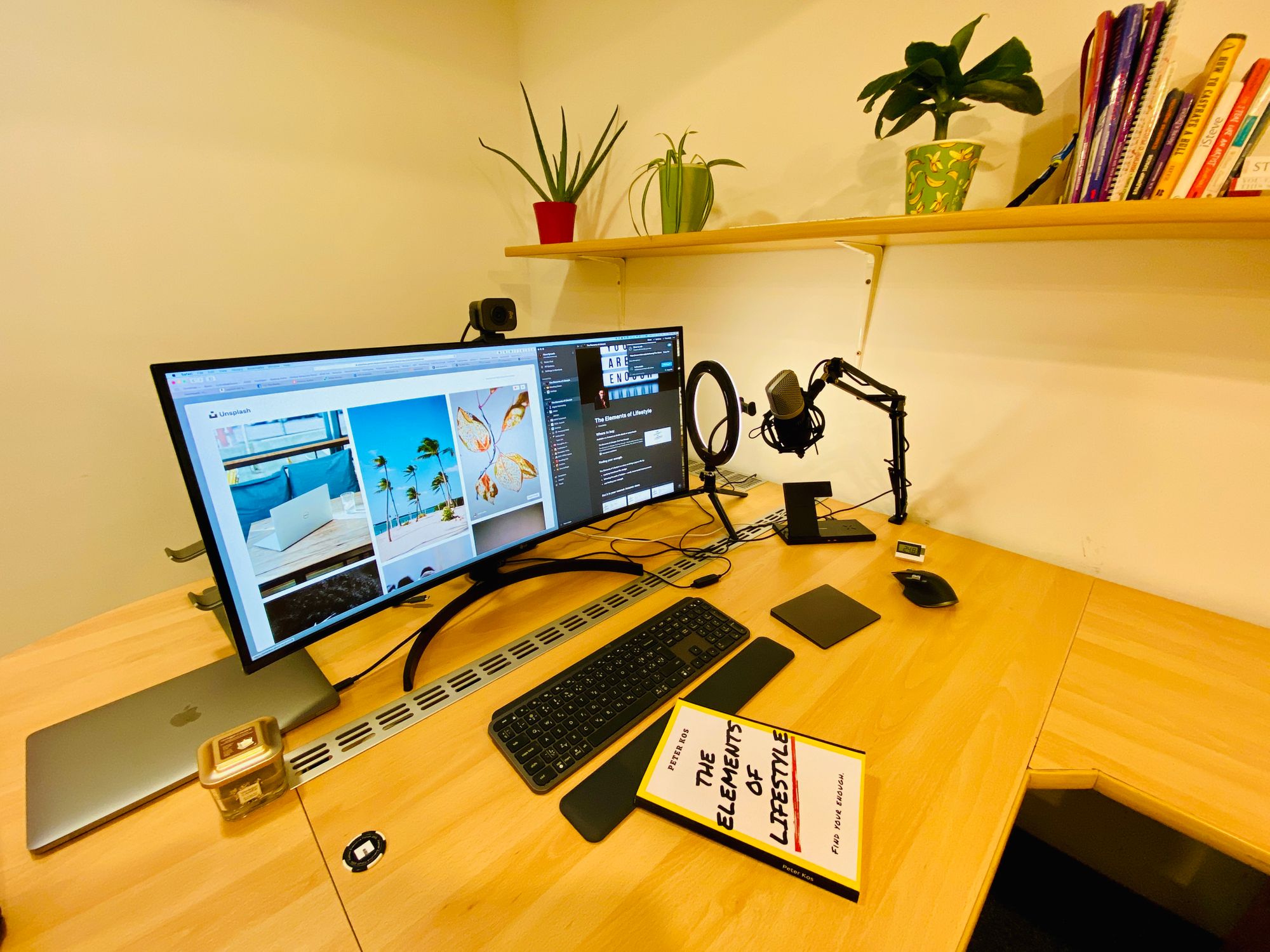Working From Home: 10 Time Management tips & tricks
This is my collection of tips & trips for time management (while Working From Home).

According to research, time management is one of the top 3 skills for modern information (knowledge?) workers, and it’s the one thing most of us struggle with. I come from Slovenia, where the busy bee is s national symbol and where “I don’t have time for ... “ is worn as a badge of honor.
🐝 Busy ≠ Productive
When I started my corporate career nearly two decades ago, I quickly noticed that everyone was busy. First in Slovenia, then in Slovakia. You always felt like you’re interrupting something. I also saw that there’s no correlation between busyness and productivity. What I mean by that is that plenty of busy people didn’t seem to churn out any tangible results. Being busy was what they did.
👩💻 Technology doesn't automatically improve Time management
During the last two decades, I got to add practice to my theories, perfect my productivity, and I also learned that no advice needs to be taken at its face value — you take what you need and discard what you don’t. I’m mentioning a couple of examples in my book.
Here we are, ten Moore’s law cycles later, and we’re still struggling with the same thing. I gave out lots of time management advice over my career, and I’ll dispense some now. It’s not specific only to working from home because — no matter how we feel — the time is still running at the same clock speed.
Here’s my advice to better manage your time while working from home.
🗺 Plan
I’m a big believer in planning, and it’s helped me live a life of joy. Don’t think that’s dull — at times, I ran on a no-plan plan, but it was still planned.
When talking about WFH specifically, I’m not asking you to plan out the next decade. Start small: plan your week, then plan your days. There’s no need to go further than a week or two out. But don’t show up on Monday morning and start guessing what to do.
The best time to plan your workweek is on Friday or Sunday. My choice is Friday so that I can finish with a review and an outlook. Knowing what to expect in the coming week helps me have a more relaxed weekend.
Include the main tasks you want to achieve, but not more than three to five per day, and not more than three big ones per week. Once you know what has to be done, it’s easier to schedule it, and schedule you must. Good time management starts in the calendar, not in the task list. Let me repeat that: good time management happens in your calendar, not your task list.
Tasks without assigned time slots is a grocery list.
🗓 Put everything in your calendar.
Be considerate about how much time each thing needs. Don’t allow standard settings to dictate your time. If something is 10 minutes, block that. If it’s an hour and fifteen, block that. Just plan it. With experience, you’ll learn where you missed the reality, and it only gets easier.
Make it a rule to have everything on the calendar. That includes working hours, lunch breaks, playing with the kids, napping if you must. The calendar’s purpose isn’t to brag about being busy; it helps you navigate your life. With shared calendars, don’t forget to “mark as private” the things you don’t want others to see. My rule is that my calendar is mine only, and other people in my organization only get free/busy visibility, not the details. I still use private events, but it just makes me feel more comfortable knowing I’ve got some privacy.
⚖️ Balance
Once your week is planned out, check back to make sure you have some balance in there. You can’t expect to push yourself at 100% all the time. Breaks, meals, and downtime are all part of the day. So are distractions. Any escalations and unexpected things that might pop up — have a time slot for those. Park them into those slots, and don’t let them interrupt your plan.
If you’re a leader, consider that you’re also setting an example for those you lead. That taught me to be very mindful about when I’m reaching out to people. My rule is not to send emails before 7 am, after 6 pm, nor during the weekends. This way, I can let my team relax and recharge.
🧳 Prepare
Once everything is planned, it’s easier to prepare. If you know there’s a big meeting coming up, you can pencil in some prep time to work on that presentation or a report. Or add fifteen minutes before the start to review related materials. Very few people do that, and it’s an instant advantage.
When I used to travel non-stop, I’d review notes during the taxi rides. But now I get to do it in the comfort of my (home) office.
For me, preparation includes opening up a new document in Notion or taking digital handwritten notes — in Apple Notes. I’ll also chalk out some points I’d like to get across, questions I might have, or my objectives for the meeting. A couple of bullet points to guide me.
People appreciate when you prepare; it’s respective of their time. You’ll appreciate it too, as your meetings and discussions get much more fluent whey you’re prepared.
👮🏾♂️ Discipline & Management
Things won’t always go as planned. Meetings get canceled, people get sick, emergencies come up. But that’s no excuse to avoid planning and preparation altogether.
Everyone has a plan until they get punched in the face
—Mike Tyson.
You can always adjust your schedule, but don’t let anyone disrespect your time. If someone keeps being late, you’ll need to warn them about it (yes, even if it’s your boss).
In my experience, the most problematic are those with constant last-minute requests. First, send them this article, as they need some time management advice.
Second, you’ll have to stop playing their game. This works with having predefined calendar slots for dealing with unexpected things and then parking their requests in those slots.
When this offender comes to you with URGENT: I need this in 2 hours — BEFORE EOB TODAY, reply that you can deal with this last-minute thing tomorrow between 13:30 and 14:00 (or whatever your slot it). When they come back in a panic that THEY REALLY NEED IT BEFORE EOB TODAY, apologize that you can’t fit this last-minute request in your schedule today.
You’ll have to make them suffer once; that’s part of the learning curve. This is how you get to manage your time — by managing other people’s expectations and respect for your time.
Stick to agreed time slots. Show up on time, end the meeting as agreed. Don’t let a boring meeting with a slow speaker go on for too long. Be polite and get out.
If you’re new to this, then the first week or two might be challenging. You’ll have to get out of your skin and stay on track. You are teaching yourself, and you are teaching others.
Discipline is key. You’ll have time for flexibility later.
🪄 Small tips & tricks
There are very few jobs where you’re expected to reply to emails within seconds. That’s why there are zero reasons to keep those distractions (you might call them notifications) turned on. Don’t let your email app beep you out of your flow. And turn off those email pop-ups on your computer as well. They are useless and distracting, and the most embarrassing ones come while you’re sharing your screen. You are better than that.
With the phone notifications, my default setting is ALL OFF except the ones I pick. Every time I install a new app, I disable all notifications and only allow them if I really have to be distracted. Those little red dots and numbers on top of the app icons — how do they serve you? What’s the value of knowing that you have thousands of unread emails? Turn it all off. Beeps, pop-ups, badges. Then turn on only the ones you might really need. For me, that’s SMS and WhatsApp messages, and they’ll only come through if it’s my immediate Team or my family. Everything else is delivered silently into the notification center, and I get to choose when to check them.
⚙️ Batch process
Which brings us to one of the best productivity techniques I know — batch processing. Instead of allowing email to distract you non-stop, disrupting your flow, messing with your mindfulness, decide on when are your email processing times.
For example, check inbox at 0830, and then again at 1145, at 1400, and so on. See what works for you, and block that time in your calendar. If you have little tasks and approvals that you need to keep processing, you can adjust the slots to your needs, but don’t let them happen all the time.
You can batch process whatever tasks can be combined — e.g., phone calls, video calls, internal meetings, and so on. Monday is the usual sales meeting day, so you could try to make the whole Monday for the internal discussions.
And if you know that you’re most creative in the morning, leave that time for creative work, whatever that might be (for me, it’s strategic/tactical planning and presentation decks). If you know that you get lazy in the afternoon, leave email or training recordings for that slot. Figure out what works for you and pencil it into your calendar, then stick to it.
My batch-processing tasks are emails, internal Zoom calls, phone calls (afternoons), customer/partner Zoom calls (noon/afternoon), trainings (Fridays), and so on.
📬 There’s no Inbox Zero
So many information workers spend entire days in their inboxes, trying to churn their way up to the bragging rights of Inbox Zero. If you achieve that, let me know, and I’ll send you a congratulatory email.
Inbox Zero is one of the most idiotic productivity techniques out there. Why; because having an empty inbox doesn’t mean that (any useful) work is done, and you don’t control that state. The senders do.
Inbox is for communication, not for productivity. Task lists are for productivity, but only when combined with the time-management powers of the calendar.
You have to be vigilant that you don’t allow your task list to become that place between the inbox and hell. You’ll have to figure out what works for you, but I mostly skip the task list — if it’s not important enough to get a slot in my calendar, it’s maybe not important at all.
I’ve tested out ALL the To-Do apps known to digital mankind, and they mostly ended up being a procrastination graveyard of the things I didn’t want to focus on. If there are more than ten items older than two weeks on your task list — why are they still there?
If you found some other good productive uses for your To-Do app, let me know, I’m keen to try them out.
🕵️ Review & adjust
Make it a daily habit to have a review at the end of your (work)day. It only takes 5-10 minutes. See what went well and what could be improved. Learn about the distractions and notice where you felt most productive. Think about how you can use that knowledge to better plan tomorrow. Adjust course. Maybe you need more downtime, shorter breaks, or lunch at different times. Perhaps you’ll find that it’s better to start early — but then also finish early. Don’t forget about your non-working hours.
If you have kids at home, try to sync up with their home-school schedule so you can enjoy a family lunch. Or block your calendar to play with them at the end of your workday — this will motivate you to finish in time.
🖇 Try async
With WFH-ing, we’re all learning that real-time isn’t the only option. We can work asynchronously at times that best suit us. Maybe you like to take a more extended break during lunch and then finish the work in the evening. Set your preferences and discuss them with your boss and other stakeholders. Your office hours don’t need to be 9-5; maybe they’re 7-10 and 14-19. Try and see what works for you and the people you work with.
🏌️♂️ Make it a habit.
If this is new for you, I have to tell you; it will be a struggle. The first week might feel terrible, but you’ll quickly notice it’s worth it, and it only gets more comfortable until it turns into a habit, and then it becomes a superpower.
Remember, we’re learning only when we’re out of our comfort zone. When we are a bit scared when there are unknowns, something unpredictable. That’s when we grow. Proper time management is the key to living a joyous life. Trust me; I literally wrote a book about it.
Working From Home is a benefit, and I hope you find the generosity to be grateful for it.
Enjoy your home office!
Don't miss other articles in the WFH Series







